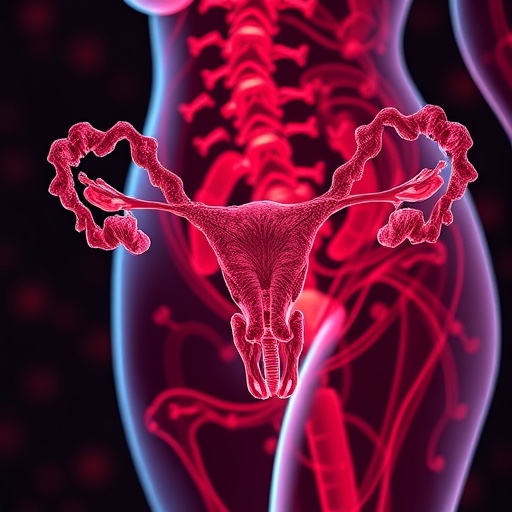In a groundbreaking study published on July 31 in Cell Reports Medicine, researchers at the University of California, San Francisco (UCSF) have leveraged big data analytics to deepen our understanding of endometriosis, a chronic and often debilitating condition affecting approximately 10% of women worldwide. By harnessing anonymized electronic health records from millions of patients across the University of California’s six health systems, the team unveiled extensive correlations between endometriosis and a myriad of other diseases, vastly expanding the clinical landscape surrounding this perplexing disorder.
Endometriosis manifests when the endometrial-like tissue, which ordinarily lines the uterus, aberrantly implants and proliferates outside the uterine cavity. This pathological ectopic growth triggers chronic pelvic pain, infertility, and systemic symptoms, significantly impairing quality of life. Traditionally, diagnosing endometriosis has been invasive, relying predominantly on laparoscopy to visually identify the lesions. Treatment options remain limited, including hormonal therapies aimed at suppressing cyclical menstruation, or surgical excision of lesions, yet many patients continue to experience persistent symptoms despite these interventions.
The UCSF research team, spearheaded by Marina Sirota, PhD, interim director of the Bakar Computational Health Sciences Institute (BCHSI), employed sophisticated computational methodologies to mine vast troves of clinical data. This approach allowed them to map the diverse health trajectories of individuals with endometriosis in comparison with control patients, revealing over 600 statistically significant associations with a spectrum of diseases. These conditions spanned well-known comorbidities such as infertility and autoimmune disorders to more unexpected links including certain neoplasms, asthma, and ocular diseases, suggesting the systemic nature of the disease.
This research hinges on an innovative fusion of biomedical informatics and clinical science, showcasing the power of data science in teasing apart complex disease patterns from real-world medical records. Bioinformatics graduate student Umair Khan utilized advanced clustering algorithms to stratify endometriosis patients into phenotypically coherent subgroups based on their unique disease histories. This stratification provided a refined framework to connect clinical observations with underlying biological processes and potential therapeutic targets.
Critically, the study also reaffirmed associations between endometriosis and migraine headaches, bolstering prior hypotheses that neurological pathways may intersect with gynecological pathology. This insight offers a tantalizing prospect that migraine pharmacotherapies could repurpose as part of a multifaceted approach to managing endometriosis-related pain, which often resists conventional hormonal or surgical treatments.
Experts like Linda Giudice, MD, PhD, co-author and physician-scientist at UCSF’s Department of Obstetrics, Gynecology, and Reproductive Sciences, emphasize the profound burden of endometriosis on patients. Beyond physical pain, women with this disorder frequently endure psychological distress, social isolation, and disruptions in professional and family life. Yet, despite its prevalence and impact, endometriosis has long languished in the shadows of medical research due to diagnostic challenges and insufficient large-scale data.
The advent of electronic health records (EHRs) and the commitment of UC health centers to data sharing have been pivotal in overcoming these barriers. According to Tomiko Oskotsky, MD, clinical investigator and BCHSI associate professor, this study epitomizes the transformative potential of large-scale healthcare datasets in unraveling diseases that defy traditional investigative paradigms. The UCSF-led initiative illustrates how de-identified patient data, once mined with precision computational tools, can illuminate disease pathways and catalyze innovation in diagnosis and treatment.
The team’s findings reinforce the emerging characterization of endometriosis as a multi-system disorder, implicating a constellation of organ systems beyond the reproductive tract. Such a systemic perspective challenges the historical view of endometriosis as a localized gynecological issue and heralds a new era of integrative research and clinical management strategies that address the disease’s complexity.
This paradigm shift has crucial implications for clinical practice. Faster, less invasive diagnostic approaches could be developed by recognizing endometriosis’s broader disease associations, potentially incorporating biomarkers or imaging techniques informed by related pathological processes uncovered through this data-driven approach. Moreover, personalized treatment regimens that consider comorbid conditions and individual patient profiles may significantly improve outcomes and quality of life.
The study was made possible by the collaborative efforts among clinicians, data scientists, and bioinformaticians within UCSF and the broader University of California system. It showcases the value of interdisciplinary research environments like the UCSF-Stanford Endometriosis Center for Discovery, Innovation, Training and Community Engagement (ENACT), which fosters cutting-edge studies aimed at elucidating multifactorial diseases through computational and clinical integration.
Financial support for this research came from the National Institutes of Health, specifically the Eunice Kennedy Shriver National Institute of Child Health and Human Development. The study represents a landmark in endometriosis research, demonstrating that harnessing the “data deluge” generated through modern healthcare can finally begin to unlock the mysteries of a condition that has long evaded full scientific understanding and effective management.
Concluding, this extensive data-driven investigation not only charts new territory in understanding the systemic underpinnings of endometriosis but also exemplifies the transformative power of computational health sciences. It is a clarion call for the medical community to embrace integrative, patient-centered research models that leverage advanced analytics, paving the way toward tailored therapies and improved diagnostic precision for millions of women suffering worldwide.
Subject of Research: Endometriosis and its systemic disease correlations revealed through analysis of large-scale anonymized patient health records.
Article Title: Big Data Begins to Crack the Cold Case of Endometriosis
News Publication Date: July 31, 2025
Web References:
References:
- Authors: Marina Sirota, PhD et al.
- Funding: NIH Eunice Kennedy Shriver National Institute of Child Health and Human Development (P01HD106414, T32GM067547, T32GM142516)
Keywords: Endometriosis, Chronic Pain, Computational Science, Autoimmune Disorders, Cancer, Migraines, Infertility, Hormone Therapy, Data Analysis, Discovery Research, Menstruation, Uterus




